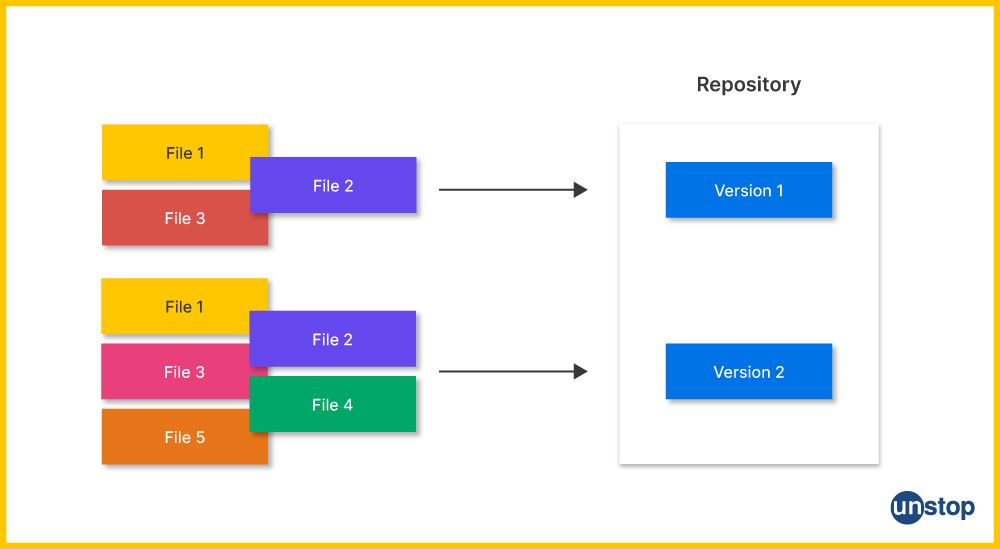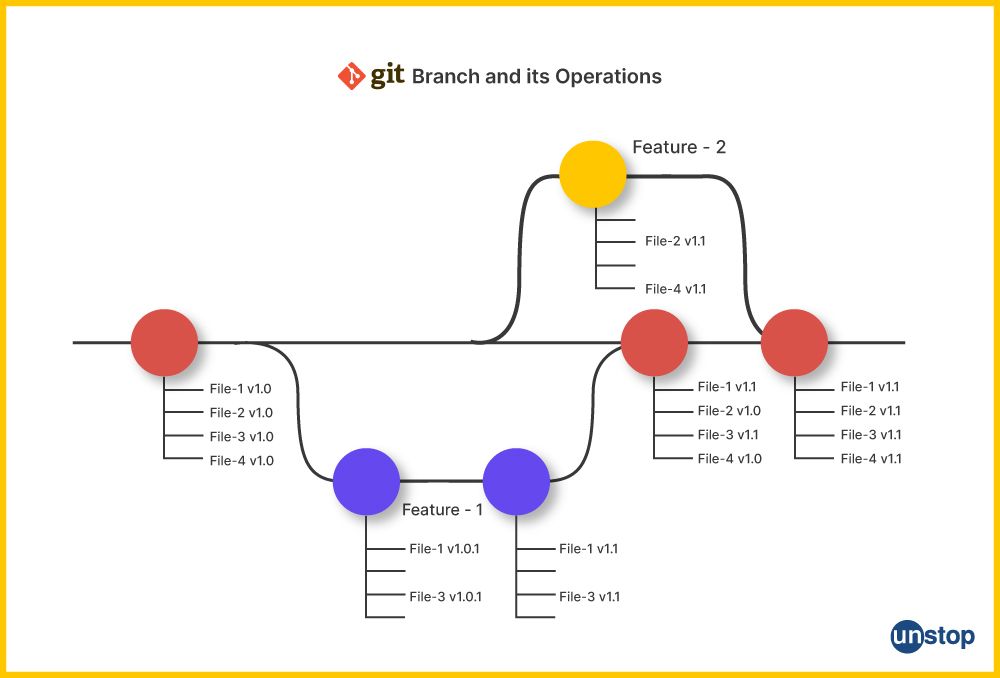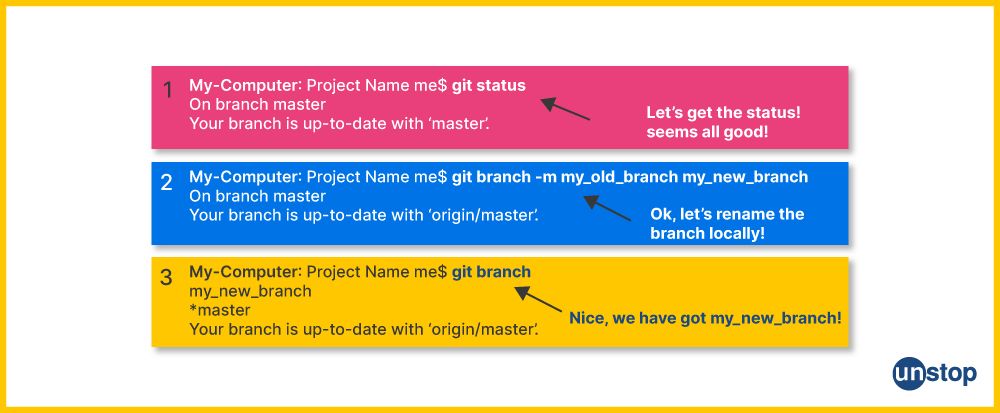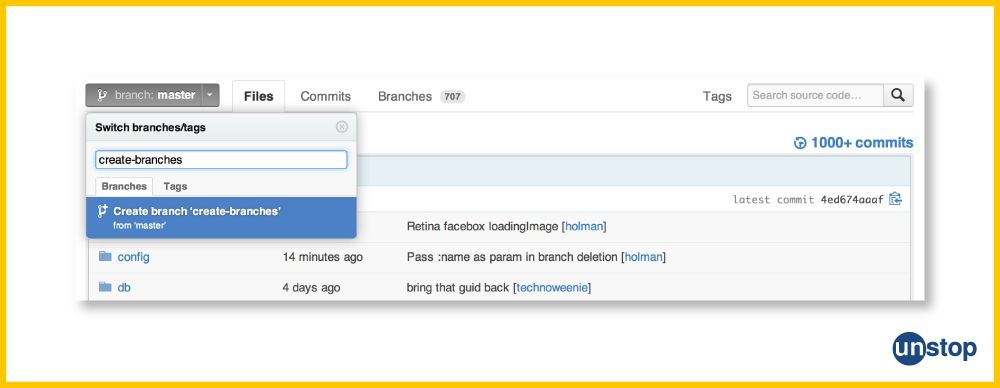- What Is GitHub?
- Git And GitHub- A Comparison
- How To Use GitHub?
- Components Of GitHub
- GitHub For Developers
- Tips To Create Your GitHub Portfolio
- Who Uses GitHub?
- Conclusion
- Frequently Asked Questions
- How Well Do You Know GitHub? Take A Quiz!
- What Is Git? Basics
- How Git Works?
- The Git Lifecycle
- About The Git Architecture
- The Different Types Of Git Workflows
- Common Functions Of Git
- Conclusion
- Frequently Asked Questions
- Think You Understand Git? Prove It!
- What Is Git?
- What Is GitHub?
- Git Vs. GitHub (Difference Comparison Table)
- Git vs.GitHub: Differences Explained
- Git Vs. GitHub: The Similarities
- How To Integrate Git & GitHub?
- Common Git Commands to Know
- Conclusion
- Frequently Asked Questions
- Git vs. GitHub Quiz – Let’s See What You Know!
- What Is Git?
- Git Commands: Working With Local Repositories
- Git Commands: Working With Remote Repositories
- Branch- Git Commands
- Git Checkout Commands
- Merge- Git Commands
- Clone- Git Commands
- Commit- Git Commands
- Config- Git Commands
- Pull- Git Commands
- Push- Git Commands
- Rebase- Git Commands
- Stash- Git Commands
- Remote- Git Commands
- Some Advanced Git Commands
- Conclusion
- Frequently Asked Questions (FAQs)
- Know Your Git Commands? Let’s Test That!
- What Are Git Submodules?
- How Git Submodules Work?
- How To Add Git Submodule?
- How To Remove Git Submodule?
- Pulling In Upstream Changes From The Submodule Remote
- Git Submodule Commands
- Uses Of Git Submodules
- Mastered Git Submodules? Test Yourself!
- What Is Branch In Git?
- Why Are Git Branches Essential?
- How To Create A New Git Branch?
- Managing Git Branches
- Merging Git Branches
- How To Delete A Git Branch?
- Git Branch: Commands
- Git Branching Quiz – Test Yourself!
- Prerequisites For Git Create Branch Process
- How To Create A New Branch In Git?
- Branch Naming Conventions | Git Create Branch
- Different Ways Of Creating New Git Branch
- Git Create Branch In Visual Studio
- How To Delete A Git Branch?
- Conclusion
- Git Create Branch Quiz– How Well Do You Know It?
- Frequently Asked Questions
- How To Switch A Branch In Git? | Solutions To Git Problems
- Switching Branches In Git Using Git Checkout Commands
- What Is The Detached HEAD State?
- Switching Branches In Git Using The Git Switch Commands
- Switching Branches In Git Using GitKraken
- Difference Between Git Checkout & Git Reset
- Difference Between Git Checkout & Git Restore
- Difference Between Git Checkout & Git Clone
- Conclusion
- Frequently Asked Questions
- How Well Do You Switch Git Branches? Take A Quiz
- What Is A Git Repository?
- What Are Git Branches?
- Naming Convention For Git Branches
- Why Is Name Important?
- How To Rename A Branch In Git?
- How To Rename Local Git Branch?
- How To Rename Remote Git Branch?
- How To Rename A Git Branch Locally In Command Line?
- How To Rename A Branch In Github?
- Conclusion
- Frequently Asked Questions
- Git Branch Renaming Quiz– Ready for the Challenge?
- What Branches Are In Git?
- Git Delete Branch: The Fundamentals
- When To Delete Branches?
- What Happens When A Git Branch Is Deleted?
- Git Command For Creating A New Branch
- How To Git Delete A Local Branch?
- How To Git Delete A Remote Branch?
- How To Delete A Branch On GitHub?
- Remove Vs. Local Git Branch Delete
- Git Push & Delete Remote Branch
- What Are Tracking Branches And How To Delete Them?
- Can I Recover A Deleted Branch in Git?
- Conclusion
- Frequently Asked Questions
- Ready To Test Your Git Branch Skills? Take A Quiz
- What is Git Rebase?
- How Git Rebase Works?
- Git Rebase Configuration
- Git Rebase Options
- Merge Strategies In Git Rebase
- Git Rebase Example
- Types of Git Rebase
- Git Rebase Commands
- Setting Up Branches for Rebase Workflows
- Splitting Commits In Git Rebase
- Labelling Conflicts Markers
- Rebasing Commits Against A Branch
- How To Recover From Upstream Git Rebase?
- Git Rebase Vs. Git Merge
- Best Practices For Using Git Rebase
- Git Rebase Quiz – Ready to Test Yourself?
- What Is Merge In Git?
- How Git Merge Works?
- Essential Commands To Perform Merge In Git
- Steps To Merge A Branch In Git
- Git Merge Conflict
- Types Of Git Merge Conflicts
- How To Resolve Merge Conflicts?
- Git Commands To Resolve Conflicts
- Conclusion
- Caught Up On The Basics? Let’s Test Your Skills!
- Frequently Asked Questions
- What Is Git Rebase?
- What Is Git Merge?
- The Working Of Git Rebase Vs. Git Merge
- Git Rebase Vs. Git Merge | The Differences
- Git Merge Vs. Rebase | Differences Explained
- Git Rebase & Git Merge Similarities
- Advantages & Disadvantages Of Git Merge
- Advantages & Disadvantages Of Git Rebase
- How Do You Use Git Rebase & Git Merge Together?
- Git Rebase vs. Merge. Which Is Better & When to Use?
- Conclusion
- Frequently Asked Questions
- Git Rebase vs Merge Quiz – Can You Choose Right?
- Introduction To Git stash
- Importance Of Git Stash
- How To Use Git Stash Command?
- Git Stash Commands
- Git Stash Options
- Git Stash vs. Git Commit
- Git Stash vs. Git Reset
- Git Stash vs. Git Stage
- Best Uses/ Practices Of Git Stash
- Conclusion
- Frequently Asked Questions
- Git Stash Quiz – Are You Ready?
- What Is Git Cherry Pick?
- When To Use Git Cherry Pick Command?
- How To Use Git Cherry Pick?
- Git Cherry Pick For Multiple Commits
- Undo Changes & Restore Lost Commits With Git Cherry Pick
- Git Cherry Pick Example (Command Line)
- What Happens When We Cherry Pick A Git Commit?
- Sequencer Subcommands In Git Cherry-Pick
- Does Git Cherry Pick Create A New Commit?
- Git Cherry Pick Conflict
- Git Cherry Pick vs. Git Rebase
- Is Git Cherry Pick The Same As Merge?
- Advantages and Disadvantages Of Git Cherry Pick
- Hidden Git Cherry Pick Commit
- Conclusion
- Frequently Asked Questions
- Think You’ve Mastered Cherry-Picking? Take A Quiz!
- When To Use Git Tags?
- Creating A Git Tag
- Types Of Git Tags
- Listing Git Tags
- Tagging Old Commits
- ReTagging Or Replacing Old Git Tags
- Sharing: Pushing Git Tags To Remote
- Deleting Git Tags
- Checking Out Git Tags
- Git Tags: Manage & Add Versions To Project History
- Git Tags & History of Commits
- Conclusion
- Common Git Tags Questions/FAQs
- Git Tag Quiz – Ready to Test Yourself?
- What Are Git Hooks?
- How To Create GIT Hooks?
- Scripting Languages In Git Hooks
- Scope Of Git Hooks
- Types Of Git Hooks
- Difference Between Client-Side & Server-Side Hooks
- Local Git Hooks & Workflow
- Types Of Server-Side Hooks & Their Functions
- How To Use Different Git Hook Scripts?
- Application Of Git Hooks With Examples
- How To Find and Fix Trailing Whitespace In Commits?
- Tips For Writing Effective Git Hooks
- Conclusion
- Frequently Asked Questions
- Git Hooks Quiz – How Well Do You Know Them?
Git Rename Branch | How To Rename Local & Remote Branch With Ease

A Git rename branch refers to changing the name of an existing branch in your local or remote repository branch. It can be done using the git branch command followed by the old and new name, for example, git branch -m <old_name> <new_name>. In this article, we will discuss the process of renaming Git branches in detail.
We will also discuss the naming conventions you must adhere to when renaming a Git branch. The most important of these is to keep it descriptive with words that accurately describe its purpose. Also note that this change will not happen until you run a second command, i.e., the git checkout command, which updates your working directory with any changes made on other branches since the last checkout. Furthermore, if there have been pushes or pulls from an upstream branch (remote) repository, they must be carried over to ensure nothing gets lost in transit.
What Is A Git Repository?

A Git repository stores the version history of one or more project files. This provides an easy way to track changes, share data with others, and synchronize project folders across multiple devices.
- A Git repository can be hosted on a remote server (such as GitHub) or locally on your computer's hard drive.
- Git repositories store all the necessary information about each file, including its content at every revision, time stamps, comments written by collaborators, and other metadata like user names.
- This makes it possible for users to quickly roll back any undesired changes that were made in previous versions using Git commands such as git checkout or git revert.
- Such commands eliminate the need for the developer to manually undo changes through text editors such as Notepad++ or Atom editor, which could be quite cumbersome depending on how many modifications have been done between revisions.
Additionally, Git keeps track of different branches so new features can easily be tested separately from the existing codebase before being merged into the main trunk when ready. It maintains traceability throughout the development process if required due to security regulations within certain industries.
Overall, Git is very well adapted for modern-day distributed teams requiring agility, rapid development cycles, and frequent code changes. It makes collaboration between multiple developers easy, leading to higher productivity by minimizing communication overhead associated with such activities compared to other version control systems like SVN or CVS.
What Are Git Branches?

Git branches are pointers to a specific commit in the repository's history. They allow you to switch back and forth between different versions of your code, making it easier to collaborate on projects by enabling them to work on separate features while accessing the same core project.
- Branches can be created from any existing branch or commit so that each developer can make a copy of the original version with modifications during development without affecting other team members' changes.
- A Git branch is like a mini-repository within one overall repo, giving developers an isolated space to develop new features or bug fixes without disrupting colleagues' workflow.
Once all the changes are made, the branch can be merged with the master branch, and all changes will come together in one place. This ensures that everyone on the team can access up-to-date versions of work.
Naming Convention For Git Branches

Choosing an appropriate naming is important when renaming a branch in Git. This involves following several key rules and conversions including:
- Using hyphens or underscores instead of spaces: Hyphens (-) and underscore (_) should both be used interchangeably within names for clarity. This helps programs and other users read names more easily. Example: my-branch_name.
- Start with lowercase: Names should start with lowercase letters as part of the standard conventions established across many programming languages. Example: my-branch-name.
- Make it meaningful: The purpose of the branch should also be evident from its name to make it easier for others to understand what changes have been made. Example: feature/admin_login.
- Avoid long names: Longer names may not always appear correctly in different viewing options within Git. It is hence best to keep them short and simple but still descriptive enough that their function can be understood at a glance. Example: bugfix/issue1234.
- Keep branches consistent: It is also important to ensure the naming conventions used for each branch align with those used by other developers and teams working on the same project. This could involve using a specific prefix or suffix for different features. Example: feature/admin_login.
Why Is Name Important?
The significance of a name, particularly in Git branches, cannot be overstated when it comes to streamlining development workflows, enhancing collaboration, and maintaining a well-organized project history.
- Renaming Git branches can help keep track of project changes (especially with larger sizes of projects) and make them easier for developers to understand.
- When creating new features or fixing existing issues, naming an appropriate branch helps other team members know what kind of code changes are being made before they look at your Git log or pull requests with that same name listed on it.
- It’s also helpful for organizing tasks related to specific feature enhancements. That is, by appending relevant keywords like 'bugfix' or 'refactor' onto a branch name, you have further insight as to what was worked on during its lifetime.
- Additionally, renaming branches offers another layer of communication between colleagues who may not often talk about their work progress outside direct collaboration efforts. This way, everyone knows how each task progressed over time, which aids in faster issue resolution down the line.
In summary, the importance of naming in Git branches lies in its ability to enhance project organization, facilitate collaboration, and provide valuable context for developers, ultimately leading to improved version control and smoother project management.
How To Rename A Branch In Git?
We have already discussed the conventions to use when naming or renaming Git branches and the importance of the names. Now, let's look at the process of renaming a Git branch. It is as follows:
- The first step is to checkout to the local branch which you want to rename with the git checkout <old_name> command.
- Next, rename the local branch with the git branch -m <new_name> command, where new_name refers to the name you want to assign.
- After changing the name, you must push the new name of the local Branch with the -u option. This will link the checked out (and renamed) branch up with the original remote repository and its corresponding newly named/renamed remote tracking as well on Git Version Control System. The command to be used is- git push origin -u <new_name>.
- Next, delete or remove the old unused Git (local & remote) branch info. For this, you will have to delete it from the list shown by using the following command line interface remarks in the Git bash shell's terminal window:
List all available local & remote branches→ git branch –a→ Delete previous unused local branch only → git branch –d<branchName> → Delete old unused remote tracking information of the previous name that has been eliminated/removed locally. - Finally, list all branches to check whether your requested renaming activity was successful (or not) by running the git branch -a command.
Note: Leftovers could still reside at the server-side repo directly via SSH/HTTPS protocol interactions even if the 3rd step is executed correctly. In this case, run the git fetch --all --prune (or git remote prune origin) command to clean the server-side repository too.
How To Rename Local Git Branch?

A local branch in Git is a separate line of development that exists only on your local machine. It allows you to work independently on specific features, bug fixes, or changes before integrating them into the main project. There are two primary ways of renaming a local Git branch. We have explained both of these below.
Method 1: Renaming Local Git Branch With Checkout Branch
The first method involves renaming a local branch while you are currently on that branch. Here's a step-by-step breakdown:
- Check Your Current Branch: Before renaming a branch, verify that you are on the branch you want to rename by using the git branch command. This command lists all existing branches and highlights your current branch.
- Rename the Branch: To rename the current branch, use the git branch -m <new_branch_name> command.
For example, if you want to rename the branch from old_branch to new_branch, the command will be git branch -m new_branch. This will rename the branch and keep track of the old branch name for you.
Method 2: Renaming Local Git Branch Without Checking Out
The second method allows you to rename a local branch even on a different branch. It's more flexible in terms of your current working branch. Here's how to do it:
- Stay on Your Current Branch: You can change the name of another branch while remaining on your current branch, i.e., there is no need to switch to the branch you want to rename.
- Rename the Branch: Use the git branch -m <old_branch_name> <new_branch_name> command to rename a branch without switching to it.
For example, let's say you want to rename the branch testing_branch to testing_branch_3 while you are on the master branch. Then, the git branch -m testing_branch testing_branch_3 command will rename the specified branch to the new name provided.
Note: Both methods are effective for renaming local branches in Git, but the second method allows you to rename branches without needing to be on the branch you want to change. Remember to use these methods carefully, update any remote references, and communicate the change to your team if necessary.
Updating A Local Clone After Branch Name Changes
When a branch name changes in the remote Git repository, you must update your local clone to reflect those changes. Otherwise, you won't be able to fetch or pull from that branch and may encounter other conflicts when pushing back up.
Here are the steps for updating a local clone using the clone command after a branch name change:
- Fetch any new data from the remote repository into your local copy of the project using git fetch <remote_name>. This ensures all branches on both repositories have updated their latest content.
- Get an overview of what has changed by running the git log -p --graph command so that each commit can be examined and compared between repositories (e.g., staging vs. production). Add details like include/exclude authors or restrict commits within certain dates via additional flags, e.g., --author= "John Doe" --since= "last week."
- Delete any references locally for this to prevent merge errors later if there was anything not already checked out when syncing through fetch. The command will be rm -rf .git/refs remotes/<remote_name>/new_branch_name>.
- Update tracking info with the newly renamed branch using the git remote set-head <remote_name> -a <new_branch_name> command.
- Checkout the newly named branches locally & push back up to origin as needed with the git checkout <new_branch_name> && git push --set-upstream origin/<new_branch_name> command.
- Validate that everything was successful by running the git status command and reviewing all local files and any other related change sets that may have been made during this process.
- Lastly, tag the version changes locally and remotely if needed, with the git tag -a <version-number> -m "<description>" && git push --tags command. This allows versions to be tracked and reverting easier for future releases.
How To Rename Remote Git Branch?

A remote Git branch is located on a remote repository, typically hosted on a server, that can be used for collaboration and code sharing.
The syntax for renaming a remote Git branch is:
git push <remote-name> <old-branch-name>:<new-branch-name>
Here,
- <remote-name>: Specifies the name of the remote repository where the branch is located, often named origin by default.
- <old-branch-name>: Represents the current name of the branch you want to rename.
- <new-branch-name>: Refers to the new name you want to assign to the branch during the renaming process.
Now that we know the syntax/ command to rename a remote Git branch let's look at the process of carrying this change out.
- First, identify the name of the remote that you want to rename the Git Branch on. You can do this with the git remote -v command, which lists all remotes associated with your repository and their corresponding URLs. In our example, let's assume that we will use origin as our main/primary Remote URL (this will usually be true).
- The next step is to run the git checkout command with the –b option to create a new branch from an existing one by providing both old & new names. For example, git checkout -b old_name => new_name.
Alternatively, we can apply it directly when pushing changes to our remote server by running the git push origin old_name => new_name command. This way, instead of creating a whole new branch, we change or update what already exists remotely via Rename Command Syntax. - Next, you should see two branches (old_name & new_name) listed on the Remote Repository. Once you verify the new branch has been created with the correct name, you can delete/remove the old one (old_name) from the remote repository using the git push origin --delete old_name command.
- Finally, to ensure that your local checkout is now pointing to the new_name branch as a destination for all push and pull commands, run the git checkout command followed by a new branch name, i.e., git checkout new_branch_name.
This way, all required changes can be made to the branch & you can successfully rename a Git Branch (locally & remotely).
How To Rename A Git Branch Locally In Command Line?

Renaming a Git branch locally through the command line involves a few straightforward steps for seamlessly updating branch names to reflect their purpose or content better. The steps are as follows:
Step 1: Determine which branch you want to rename by listing all the branches in your local repository. To do this, use the git branch command with no additional flags/arguments. This will list all of the branches that are currently on your computer.
Step 2: Checkout (switch to) the target branch you would like to rename using the git checkout <branch_name> command. For example, if you want to switch from the master branch to a different existing branch called example-branch, then you will have to run the command git checkout example-branch.
Step 3: Rename the existing Git branch using the git -m flag command and specify a new name for your old named Branch. For example, say you want to rename a branch called old-branch to new-brand. Then, you must run the command git branch -m old_brand new_brand.
How To Rename A Branch In Github?

Changing the name of a branch on GitHub is a simple yet important task that allows you to maintain a well-organized and meaningful repository. The process to rename a branch in GitHub is as follows:
- Log in to your GitHub account and navigate to the repository for which you wish to rename the branch. For this, click on the Settings button/ icon, usually located near the top of the page.
- Navigate to the Branches tab from within Settings, which should be on a link at the left-hand side table of contents list or somewhere similar. This can vary depending on your theme/layout preferences selected when setting up the Github account.
- Under Branches, locate existing branches created by yourself or others that require renaming - these will be listed under 'Branch protection rules'.
- Once located, click the 'Edit' option next to the respective feature requiring alteration for changing its name while preserving all relevant data contained in it. This can involve simple rephrasing, such as adding underscores (_), dashes (-), numbers, words, etc., depending upon individual needs.
- Next, type in the desired new title/ name (as per the naming conventions) in the indicated empty field & press the save changes button. Following that, sync the latest settings related to the main remote's repositories by pushing the respective latest renamed information.
If you follow these steps, you'll have successfully changed the name of a particular branch on Git Hub.
Conclusion
it is safe to say that renaming branches in Git can be a powerful strategy for project management and collaboration. It allows multiple users to work on different features of the same codebase while keeping track of changes from one version to another with relative ease.
- Additionally, the naming convention ensures consistent organization within the repository.
- It makes it easier for everyone to understand what has been done without looking further into git logs or pull requests.
- Renaming both local and remote branches can be easily accomplished by following certain commands as outlined above using methods.
- This includes the git branch -m <oldname> <newname> command, which is an efficient way of creating new feature versions in smaller increment cycles that are easy enough, even for those unfamiliar with command line programming basics.
Frequently Asked Questions
Q. How do I rename a branch in Git?
To rename a branch in Git, you must use the git branch -m <old_name> <new_name> command. The old_name refers to the name you want to replace, and the new_name refers to the name you want to give to the respective branch. This command will move all commits from your old-named branch to the new one and delete the original.
Q. Can I change the name of my master or default branch in Git?
Yes, it is possible to change the default master or default branch names. For this, you must use the git checkout --orphan command followed by the new name, i.e., <branch_name>.
However, when doing so, any content currently present on those particular branches will be removed. Hence, additional steps may need to be taken against that being done for redundancy measures sake (possible backups of the original code base, etc.).
Q. How can you list and choose branches from a branch dropdown menu in Git?
Unlike other tools, Git does not come with an integrated dropdown menu from which users can select their branches. Usually, one can pick a branch through the git checkout branch-name command lines.
Q. How can I list all branches available on my local repository using Git commands?
The best way to list all available branches within your local directories with Git commands would be to enter the $ git host –v/-vv command. This will give the verbose output information about them, updated & listed as shown below:
$ git branch -v * master 6e715fd Add feature1.2 Incarnate (branches named according to their refs commit ID & instances archaeological order) develop 2f6b66d fixed typo bugfix/issue 2ef4f45 HotFix for Issue #125 Version 1.0 rel-113 8db1803 minor fixes per comment 486
Q. Is it possible to switch between branches with the -M option of Git commands?
You can use the –M option with Git commands to switch between branches if available on your local repository or remote destinations such as GitHub. However, when doing this, it is recommended that all changes be committed first before changing over branched for redundancy measures sake.
Q. Which common branch operations can be performed when working with multiple branches on a project via Git commands?
Some key operations associated with working on multiple branching structures via git would include:
- Version control,
- Commit management, and
- Pull request reviews across different pull request response threads based on main development branch conflicts troubleshooting resolved.
Other common tasks include performing merges, staging changes for later alterations, deleting redundant branches, or integrating upstream remote tracking commits, etc.
Q. How can one check what was previously committed and review its branch status within different branches using Git commands?
To check what was previously committed and review its branch status within different branches using git commands, one can use the git log command. The command will list all merged commitIDs against the intended branch-related refs, along with other helpful information. This includes the author details/date of modifications & unique SHA1 reference keys that can be used for further debugging sessions if required.
Git Branch Renaming Quiz– Ready for the Challenge?
Now you know how to rename a Git branch. Here are a few other topics to quench your thirst for knowledge:
- Git Hooks | Definition, Usage, Types, Workflow & More (+Examples)
- Git Rebase | Merge, Commands, Best Practices, Examples & More
- Git Cherry Pick Command | How To Use, Undo, Resolve Conflicts & More!
- Introduction To Git Stash | How To Use Git Stash Commands
- What Is GitHub? An Introduction, How-To Use It, Components & More!
An economics graduate with a passion for storytelling, I thrive on crafting content that blends creativity with technical insight. At Unstop, I create in-depth, SEO-driven content that simplifies complex tech topics and covers a wide array of subjects, all designed to inform, engage, and inspire our readers. My goal is to empower others to truly #BeUnstoppable through content that resonates. When I’m not writing, you’ll find me immersed in art, food, or lost in a good book—constantly drawing inspiration from the world around me.
Login to continue reading
And access exclusive content, personalized recommendations, and career-boosting opportunities.
Subscribe
to our newsletter
















Comments
Add comment